It is the task of the court to clarify if a certain case of environmental destruction is ecocide. Ecocide is the destruction of the global environment. End Ecocide on Earth is therefore defining Ecocide crime as “an extensive damage or destruction which would have for consequence a significant and durable alteration of the globalcommons or Earth’s ecological systems“ – upon which rely all living beings in general and humankind in particular – and in compliance with the known planetary boundaries.
End Ecocide on Earth means by global commons: the oceans and seas beyond territorial waters, the atmosphere, outer atmosphere and their respective chemistry, Arctic, Antarctica, cross-border rivers and lakes, ground water, migratory species, biogeochemical cycles, genetic heritages. These spaces and species which belong to no one, and called Res nullius in law, should no longer be the scene of pollution and abusive predation. This would further the protection of the global ecosystem, and in any case the principle of national sovereignty should not be claimed to shirk all liability when they are impacted. Then, a test must be applied examining the size, duration and impact of the extensive damage, destruction, or loss of ecosystem(s).
The Guardian has also identified 10 ecocide hotspots and EJOLT has implemented a global database of ecological conflicts and spaces of resistance – some of them could be considered as ecocide (featured map coming soon) – (press SHIFT and drag the mouse to zoom into an area):
Below, you find a number of examples that could potentially count as ecocide.
It is the task of the court to clarify if a certain case of environmental destruction is ecocide. According to the definition of ecocide adopted by End Ecocide on Earth, and more fully detailed in 17 Amendments to the International Criminal Court Statute , first it must be certified that an ecosystem was or will be damaged (an ecosystem is a community of living organisms and their environment which build a system exchanging matter and energy). Then, a test must be applied examining the size, duration and impact of the extensive damage to, destruction, or loss of ecosystems.
In 2010 the Guardian has also identified 10 ecocide hotspots
Below, you find a number of examples that could potentially count as ecocide:
- Agent Orange, 1961-1971, Vietnam
- Alberta Tar Sands
- Fukushima’s Debris
- Disappearance of the Aral Sea, Central Asia
- Bee colony collapse
- Oil exploitation of the Niger Delta
- Palm oil, Indonesia
- Belo Monte
- Prestige oil spill
- Ecocide in Greece – Gold Mining project in the northern region
- Ecocide in Romania – Rosia Montana
- Ecocide in Finland – Talvivaara Mine
- Pesticides and Birds
- Nuclear power plants
- Hydraulic fracturing (fracking)
- Atlantic Bluefin tuna
- CCS – Carbon Capture and Storage
- The Ajka alumina sludge spill, 2010, Hungary
- Doñana
- Great Barrier Reef under threat
- Mountaintop removal mining
- Opencast mines
- Ecocide in India – Bhopal 1984
Agent Orange, 1961-1971, Vietnam
 ‘Agent Orange’ is the code name for a combination of two pesticides: Herbicide Orange (HO) and Agent LNX. The U.S. Military used these herbicides and defoliants as part of its chemical warfare programme ‘Operation Ranch Hand’. In 1961 and 1971, the U.S. government and the Republic of Vietnam (South Vietnam) used the ‘Rainbow herbicides’ (Agents Orange, Pink, Green, Purple, White and Blue) to defoliate forests and mangroves in order to clear perimeters for military use and destroy crops to starve the enemy (North Vietnam and National Liberation Front). The most known of these herbicides was Agent Orange. It was used from 1965 to 1970 and scientists estimated that about 45,677,937 litres were spread during this period.
‘Agent Orange’ is the code name for a combination of two pesticides: Herbicide Orange (HO) and Agent LNX. The U.S. Military used these herbicides and defoliants as part of its chemical warfare programme ‘Operation Ranch Hand’. In 1961 and 1971, the U.S. government and the Republic of Vietnam (South Vietnam) used the ‘Rainbow herbicides’ (Agents Orange, Pink, Green, Purple, White and Blue) to defoliate forests and mangroves in order to clear perimeters for military use and destroy crops to starve the enemy (North Vietnam and National Liberation Front). The most known of these herbicides was Agent Orange. It was used from 1965 to 1970 and scientists estimated that about 45,677,937 litres were spread during this period.
In total, the ‘Rainbow herbicides’ represented approximately 72 million litres, meaning Agent Orange represented around 60%. Between 100,000 and 2 million hectares of land and forests were destroyed as a result from herbicide spraying during the war, and Cambodia and Laos being near Vietnam they were also affected.
Seven companies produced Agent Orange during the war. These included the multinationals Monsanto and Dow Chemicals. Last July, the South Korean supreme court assessed the correlation between the pesticide and skin diseases contracted by war veterans and ordered the two companies to pay €315,000 to indemnify the victims. Monsanto and Dow Chemicals refuted the decision and there is very little chance they will be forced to pay damages.
During its first trial in 1970, Monsanto falsified studies to ‘prove’ the absence of a link between Agent Orange exposition and the development of cancers among war veterans. A 1990 report from Greenpeace shows how these studies were rigged. Even though there are no European actors directly involved in this case, this is a perfect example of how an ecocide can devastate a country for decades without anyone shouldering the blame.
Alberta Tar Sands
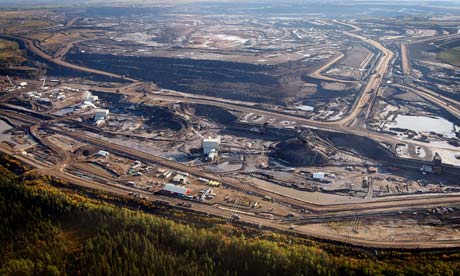
Referred to as the most damaging project on the planet, it ranks top of the list. Known as ‘dirty oil’ due to its excessively damaging outcomes, if proposed expansion proceeds, tar sand extraction will result in the loss of vast tracts of boreal forest and peat bogs of a territory the size of England. Read more at Tar Sands Network. European companies such as BP and Shell are involved and the endeavour is financed by major European banks such as Barclays, BNP Paribas, Crédit Agricole, ING, Rabobank, RBS, and many more.
Fukushima’s Debris
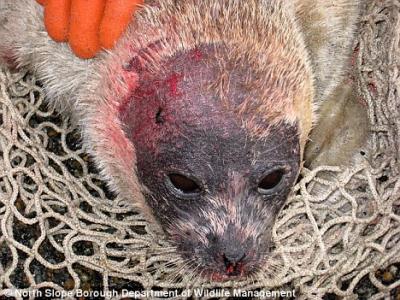 Even years after the 11th of march, 2011, the day the nuclear desaster happened in Fukushima, the nuclear power plant there is not safe for the environment. An interesting study shows, that the debris will not dissolve in the pacific ocean but will stay together and drift towards the werstern coast of North America. Alerting news are coming in from radiated seals in Alaska and critical exceedance of radiation levels in caught fishes near Fukushima and of the groundwater.
Even years after the 11th of march, 2011, the day the nuclear desaster happened in Fukushima, the nuclear power plant there is not safe for the environment. An interesting study shows, that the debris will not dissolve in the pacific ocean but will stay together and drift towards the werstern coast of North America. Alerting news are coming in from radiated seals in Alaska and critical exceedance of radiation levels in caught fishes near Fukushima and of the groundwater.
Decontamination will probably last for another 30 to 40 years. How to deal with the highly radiated mud, which is produced when decontaminating more then 100.000 tons of radiated water, which are already there is unclear. The costs are currently approximated to be 1.800€ per ton of radiated water.
Disappearance of the Aral Sea, Central Asia
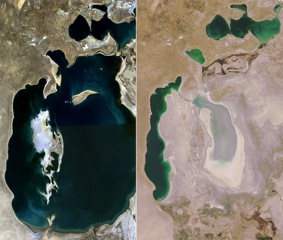 The Aral Sea is located in Central Asia between Kazakhstan and Uzbekistan. In 1960, its surface represented 68,000 km² making it the fourth largest inland sea in the world. Today it has lost more than half of its area and three-quarters of its volume.
The Aral Sea is located in Central Asia between Kazakhstan and Uzbekistan. In 1960, its surface represented 68,000 km² making it the fourth largest inland sea in the world. Today it has lost more than half of its area and three-quarters of its volume.
The Aral Sea was originally powered by two great rivers of the region: the Syr Darya and Amu Darya. These have been partly diverted to irrigate vast tracts of cotton fields which led to the drying up of the sea. Indeed, from the 60s, the Soviet Union decided to intensify the cultivation of cotton thereby spend the irrigated area of 4.5 million hectares to almost 7 million hectares in 1980.
The planned removal of this inland sea has had disastrous consequences on ecological, economic, social and health:
The drying up of the Aral Sea has turned the region into a vast desert. The sea, but also the lakes and marshes of the delta of both rivers also disappeared giving way to sand deserts. Therefore, the climate of the region has changed; average temperatures which ranged from 25 ° C in winter to over 35 ° C in summer, now varies between -50 ° to plus 50 °. The fauna and flora have so completely disappeared because of climate change, desertification and soil salinization. Fishing and agriculture in the region are affected leading to high unemployment. Finally, there is the social problem (difficult access to water) and health: health problems related to lack of water but also to soil pollution (over-use of fertilizers) and salinization (the soil salt levels increased due to a double effect: the disappearance of the sea and soil irrigation with a salt water).
Leaders USSR and now Russia obviously have a heavy responsibility for the tragedy of the Aral Sea and current consequences as planned intensive agriculture by deliberately destroying the ecosystem of the region. These practices have been widely criticized since the independence of the republics of central Asia by the new leaders who promised a greater attention to the environment. Thus, from 1990 to 1995, numerous regional cooperation initiatives have emerged which resulted in the signing of several agreements. However, today we see that, in fact, the situation has somewhat evolved. Economic interests have finally taken over, Kazakhstan like Uzbekistan continue the cotton culture of fear to degrade the social and economic situation of their country.
Bee colony collapse
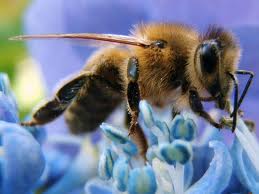
© Ricks at the German language Wikipedia
Since 2008 it is evident that the Pesticide Clothianidin is a beekiller. It acts on the central nervous system not only of the insects it is intended to kill but also others, such as bees. In July 2008, roughly 11,500 bee colonies were damaged and millions of bees died in southwest Germany. The seeds planted there were treated with Clothianidin to protect them from pests. Shortly afterwards the German Agency for Consumer Protection and Food Security (BVL) suspended permission to use this pesticide.
A review by the European Food Safety Authority came to the conclusion in January 2013 that neonicotinoids including clothianidin pose an unacceptably high risk to honey bees. Nonetheless, its use is still not banned throughout the whole of the EU.
A recent study by the american bird conservancy claims to also have evidence that birds are dying due to corn treated with neonicotinoids.
Oil exploitation of the Niger Delta
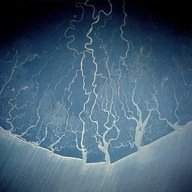 The Niger Delta, formed by the Niger River at its mouth in the Atlantic Ocean, is located in Nigeria.
The Niger Delta, formed by the Niger River at its mouth in the Atlantic Ocean, is located in Nigeria.
30 million people are living in the delta. Given the grid of pipelines and wells belonging to multinationals such as Chevron, Exxon Mobil and Total, this region is constantly polluted by oil spills. Oil extraction in the region began 50 years ago and today Shell is the largest operator in Nigeria. According to the company, criminals are responsible for the majority of leakage (theft, sabotage and terrorist activities). But according to Amnesty International, the poor maintenance of oil infrastructure and the failure of some equipment have their share of responsibility.
This is a serious ecological disaster, but also a drama that affects the inhabitants of the delta on a daily basis.
They can no longer live from the land, because it is too polluted. Fishermen must now travel dozens of miles to find fish.
A Dutch court sentenced the subsidiary Shell Nigeria on January 30, 2013 to pay compensation to one of the victims who filed a case at the court for the oil spill. While the court found that the leaks were caused by sabotage related to oil thefts, it nevertheless upheld that Shell Nigeria should have intervened to prevent the alteration of its pipelines.
However, the court dismissed the remaining claims of four Nigerian farmers and fishermen who accused the parent company Shell for polluting their villages (espacially Goi and Oruma ) in the delta, ensuring that the group did not have the obligation to prevent its subsidiaries ” of doing harm to others.” The oil company hasn’t been held responsible as parent company of maintenance facilities defect.
Palm oil, Indonesia
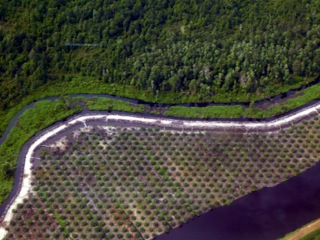
© Wakx
Palm oil is the oleaginous plant with the highest oil yield by hectare known today. For example, between 2001 and 2006, the world cumulated average yield of palm oil and palm kernel oil was 4.2 tonnes by hectare and by year against 0.4 tonnes for soya oil and 0.6 tonnes for colza oil (1).
Logic would says it is the oleaginous plant that needs the least land plantations to be cultivated but it appears productivity speaks differently…
Today palm oil can be found in one in ten supermarket products including margarine, baked goods, sweets, detergents and lipsticks (2).
Palm oil is also used for biofuel, right now the demand represents 1% of palm oil production (3) but it should increase very quickly (4).The main threat of palm oil plantation expansion is deforestation and the most affected countries are Indonesia and Malaysia. Their shared production represents 83% of the global production, causing “now the primary cause of permanent rainforest loss” a report from UNEP indicates (5).
For example, in Indonesia, 6 millions hectares are already dedicated to palm oil production and another 4 millions will be used for biofuel only by 2015 (6).
The conversion of tropical forests to palm oil plantations threatened life of lot of plants and animal species, among them, we find an emblematic one: the Orangutan, probably named after “orang hutan”, the indonesian word meaning “person of the forest” (7).
It can create social conflicts as well if “the rights and livelihoods of local communities are ignored” (8).
Palm oil plantations are also a climate threat with 1.8 billion tonnes of greenhouse gas emissions released each year by the degradation and burning of Indonesia’s peatlands (9), that affects directly neighbouring countries air pollution (10).
For one tonne of palm oil produced, 2.5 tonnes of effluent are generated from processing the palm oil in mills. If this effluent is released into rivers it could cause freshwater pollution, which could directly affect people and biodiversity (11).
Palm oil plantations are not known for excessive use of pesticides and fertilizers because there is not parasite or ravager of palm oil plants, which has not a biological solution (12).
Even so, standard nutrients such as nitrogen, phosphorus and potassium (biogeochemicals) are applied regularly to oil palm trees (13) causing disturbance in ecosystems and pollution of ground waters, rivers, lakes and seas and as a results ocean acidification (14).
In Indonesia, the monocrop of palm oil sector accounts for 3.7 million direct workers (15).
In 2009, among the actors dealing with palm oil, the top five palm oil producing companies are: Wilmar (Singapore/US) (16); Sime Darby (Malaysia) (17); IOI Corps (Malaysia); Astra agro (Malaysia); KL Kepong (Malaysia) and the top five buyers are: Unilever (Netherland); Nestlé (Switzerland); Procter&Gamble (US); Cargill (US) and Kraft foods (US) (18).
Palm oil plantation is also an issue in African countries (19).
Belo Monte
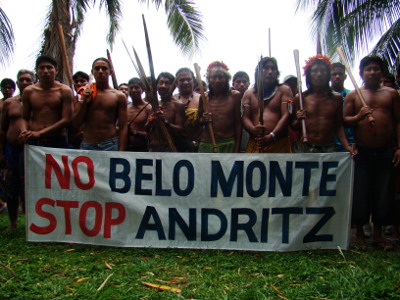
The Belo Monte Dam is a hydroelectric dam complex currently under construction on the Xingu River in the state of Pará, Brazil. By building three dams the river will be impounded, building two lakes with a combined size of 500 km². This is comparable to the size of the lake Bodensee near the Austrian, Swiss and German border.
For this dam, about 20,000 – 40,000 indigenous people will be relocated (depending on the source) and an area of 1,500 square kilometers of Brazilian rainforest will be destroyed. In addition, the dam project will affect hundreds of species, mostly endemic and some of them already in danger of extinction.
The Brazilian rainforest is a unique ecosystem. Such an extensive damage of a unique ecosystem on which we all depend for life can be considered ecocide.
European companies involved in this project as suppliers are Alstom, Andritz und Voith.
Prestige oil spill
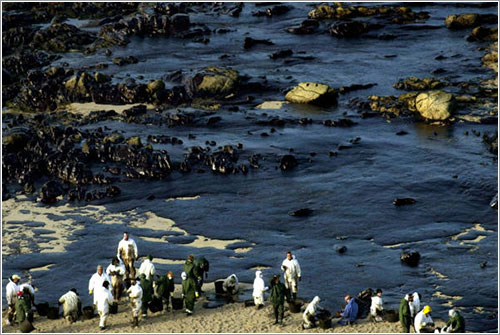
It took place in 2002 when a tanker loaded with 77,000 tons of oil, sank about 250 km from the Costa de la Muerte. This incident caused one of the biggest environmental disasters of navigation, both by pollutants released as the extent of the affected area. However, despite the seriousness of the incident, this event was full of censorship and lacking responsible.
Ecocide in Greece – Gold Mining project in the northern region
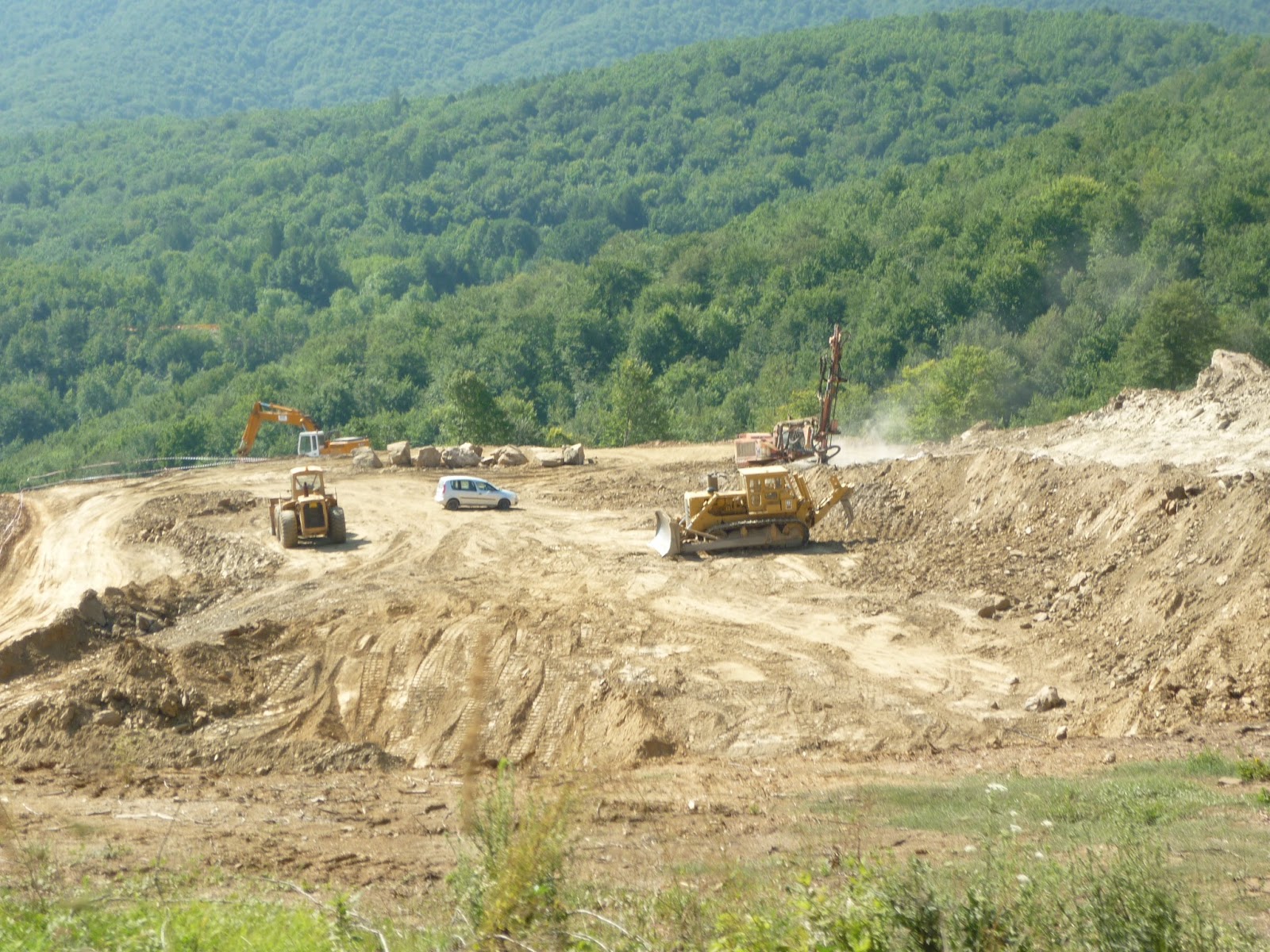
©Παρατηρητήριο Μεταλλευτικών Δραστηριοτήτων
In 2011, a Canadian company called Eldorado Gold decided to invest in northern Greece region. Its subsidiary Hellenic Gold received Greek government approval to mine in the northern peninsula. One of the first projects of the company is located in Skouries and will need 3,000 hectares of pristine forest to be cut to build the mine – says a member of the Coordinating Committee of Associations of Stageira-Akanthos Against Gold Mining (CCASAAGM). As in the Rosia Montana case (Romania) cyanide will be use to extract gold and local activists fear that the mining operation will drain and contaminate local water reserves and fill the air with dangerous substances such as lead, cadmium, mercury and arsenic. Many manifestations against the mining projects have been held in the country over the past 2 years. Riots in the region have been, sometimes, so violent that Amnesty International has reported possible human rights violations in 2013. The company announced it would push back the start of the project from 2015 from 2016-17 but denied giving up the mine. The Canadian company has 4 others projects in Europe: Stratoni, Perama Hill and Olympias in Greece and Certej in Romania. We need an ecocide law to prevent this kind of projects from happening.
Visit CCASAAGM website here
Sign the Avaaz petition here
Ecocide in Romania – Rosia Montana
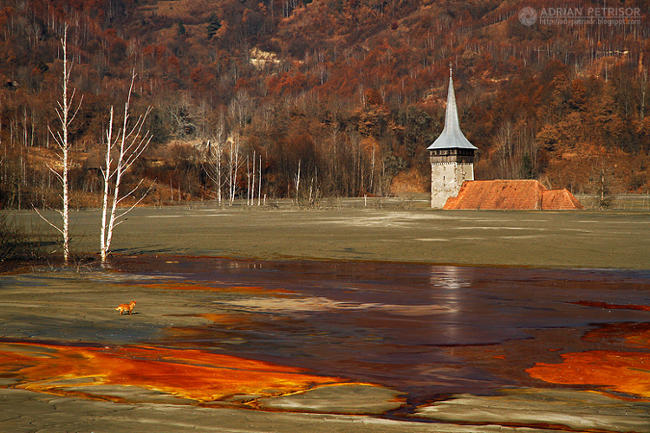 Since 2002, the habitants of Rosia Montana (Transylvania, Romania) are fighting against the implementation of a gold mining project: the largest open cast cyanide use gold mine in Europe.
Since 2002, the habitants of Rosia Montana (Transylvania, Romania) are fighting against the implementation of a gold mining project: the largest open cast cyanide use gold mine in Europe.
This project belongs to a Canadian company called Gabriel Resources. If implemented, it could leads to huge environmental, social and cultural disasters. For each year of activity, 12 000 tons of cyanide would be use for metal extraction, a giant lake filled with water contaminated with poisonous cyanide would be built instead of a village, landscape will be devastated and Roman remains destroyed. More than 900 families living in Rosia Montana already have been asked to leave their homes.
The Romanian government, which claimed to be against the project during the election, have voted a law project in favour of the gold mining company, the final decision have been taken by the Parliament, which have chosen to reject the law in December 2013. A law of ecocide would have prevented years of confrontation and would insure that this project (or some others) will not be implemented later on.
To read more about the case: http://www.rosiamontana.org/en/
Explanatory video: here
Ecocide in Finland – Talvivaara Mine
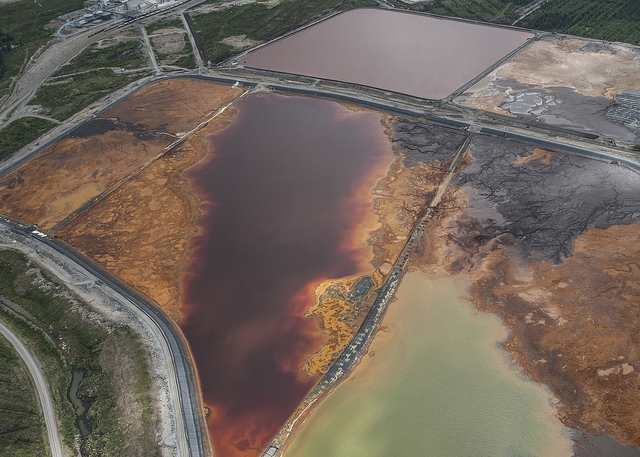 The Talvivaara mine in Sotkamo was granted a license to mine nickel in 2006. The local activist group « Stop Talvivaara » claims that since 2008 they also started to extract uranium without official permission. Despite the fact that this represents a violation of environmental legislation, it also led to a huge environmental disaster in 2012. Indeed, several leaks in the waste-water pool happened in 2008, 2010 and 2012. The last one demonstrates high concentrations of nickel and uranium into the nearby lakes. This just represents one case of ecocide happening here in Europe. An ecocide law could stop not only this but many others.http://www.stoptalvivaara.org/fi/en_adressi.html.
The Talvivaara mine in Sotkamo was granted a license to mine nickel in 2006. The local activist group « Stop Talvivaara » claims that since 2008 they also started to extract uranium without official permission. Despite the fact that this represents a violation of environmental legislation, it also led to a huge environmental disaster in 2012. Indeed, several leaks in the waste-water pool happened in 2008, 2010 and 2012. The last one demonstrates high concentrations of nickel and uranium into the nearby lakes. This just represents one case of ecocide happening here in Europe. An ecocide law could stop not only this but many others.http://www.stoptalvivaara.org/fi/en_adressi.html.
Pesticides and Birds

© Karelj
Birds play a key role in the conservation of biodiversity. Insectivores help with the struggle against some parasites and plant bugs. Birds of prey, by eating little rodents, contribute to species regulation. Scavengers prevent proliferation of diseases by cleaning up animal’s carcass before they decompose. Finally, certain birds, by carrying seeds, contribute to vegetable dispersion.Nevertheless, thousands of birds species are declining due to human activities (ecosystem destruction, hunt, pesticide poisoning). According to the IUCN (International Union for the Conservation of Nature) 13% of bird species are threatened by extinction nowadays. The book “Birds in Europe” by Birdlife International highlights the fact that on the European continent 226 species are currently considered as threatened species, or 43% of the local birds.In Europe, birds’ death by pesticide poisoning is a true blight, which has decimated populations for decades. Indeed, the first synthetic phytosanitary products appeared in the 1940’s and then became the basis for eradicating parasites and improving agricultural field yields. Only many years later the effects of these pesticides, and especially DDT, on birds and human beings were revealed.
The effects of DDT – which became the most widely used insecticide after World War II – on birds came to the public’s attention with the book “Silent Spring” written by the American biologist Rachel Carlson in 1962. She accuses DDT of being carcinogenic and reprotoxic (i.e. harmful for birds’ reproduction by slimming down the shell of their eggs). This pesticide was prohibited in 1972 and added to the Persistent organic pollutant ‘s list of United Nations.
Nevertheless, the use of pesticides continued. Producers were very creative in developing ever new products with severe side effects on biodiversity. Today, the most commonly used pesticides are neonicotinoids which damage our ecosystems by contaminating insects, plants, grounds and rivers.
In Europe, one quarter of the birds nest in agricultural fields and an even larger number use fields as sources of food. This is why agricultural pesticide exposure is potentially significant for them (exposure happening principally with contaminated food).
According to a report of the American Bird Conservancy (march 2013) neonicotinoids, the most widely used pesticides today, are lethal for birds as much as they are for bees. Only recently, a two year moratorium on the use of neonicotinoids in the EU was agreed and is coming into effect in December 2013.
However, agro-supply market leaders such as Syngenta (a Swiss company) and Bayer (a German company) producing neonicotinoids strongly oppose this legislation and lobby the European Commission to remove its proposal of restraining their use. The companies are accusing the report of the European Food Safety Authority to be incorrect.
Nuclear power plants
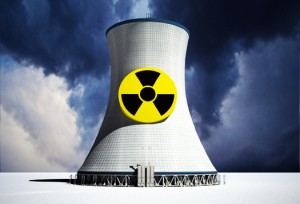
There are 427 nuclear reactors currently in operation, in 31 different countries. Even under normal circumstances, nuclear power has an impact on humans and ecosystems. Uranium mining generates an enormous amount of pollution. It contaminates thousands of workers and local residents – often indigenous peoples, who are already disadvantaged and discriminated against – in Niger, India, Australia, Canada and elsewhere. The low doses of radiation that are continuously being emitted by nuclear power plants are strongly suspected of increasing the number of childhood cancers within a 5km radius [2].
As for serious accidents…
On 26th April 1986, reactor No. 4 at the Chernobyl nuclear power plant exploded. The radioactive emissions mainly contaminated Belarus, Ukraine and Russia, but also thirteen European countries including Italy, Germany and France, and beyond that, the northern hemisphere. In 2010, the New York Academy of Sciences published the results of the research that prominent Russian and Byelorussian scientists had carried out into the health consequences of Chernobyl [4]. Their conclusion: 984,000 dead between 1986 and 2004. The health of millions of others, who have absorbed low doses of radioactivity from water and contaminated food, has also suffered: the thyroid, the cardiovascular system, the kidneys, the liver, the immune, hormonal and reproductive systems are all affected.
It is still much too early to assess the full impact of the Fukushima disaster, which began on 11th March 2011. Unfortunately there is every reason to fear a comparable or even greater toll than that from Chernobyl. In the course of two years, about 350,000 people have left their homes, but the government is now trying to get the evacuees to return to the contaminated areas. The damaged reactors continue to release high levels of radioactivity into the environment. Naoto Kan, who was Prime Minister of Japan in 2011, now maintains: “the best guarantee of safety in the nuclear industry is to have no nuclear power at all.”
There are hundreds of European companies involved in the nuclear sector, including some global players such as Areva, EDF and GDF-Suez.
Hydraulic fracturing (fracking)

(c) EcoFlight, Bruce Gordon
Induced Hydraulic fracturing, commonly known as fracking, is a technique used to extract hydrocarbons such as natural gas and petroleum from the ground. Large reservoirs of natural gas and petroleum are stored in sandstones, limestones, dolomite rocks, shale rocks or coal beds. In order to release these resources, a fluid is injected into the ground at high pressure, so that the rock cracks and the natural gas stored inside is released. Using this technique, natural gas and petroleum stored between 1.5 and 6km beneath the earth’s surface can be accessed. Fracking has potentially severe side effects, including the contamination of ground water, air pollution, the migration of gases and hydraulic fracturing chemicals to the surface, and surface contamination from spills and flowback, all of which impact not only on our natural environment but also constitute a potential threat to human health. Scientists agree that emissions from shale gas obtained through fracking are much higher than CO2 emissions from burning standard natural gas. This is due to the potential of methane leaking during the process which is much worse for climate change than CO2. In addition, a large amount of water is needed in the process, given increasing water scarcity around the world an irresponsible waste of resources. Fracking is particularly relevant in Europe as scientists expect large amounts of natural gas to be buried in European soil which could be accessible using this technology. Several EU countries such as Bulgaria, Denmark, Germany, Poland have started investigating the options given the recent economic “success” story of shale gas in the US. The Netherlands and the UK are already practicing it. France has banned fracking.
Atlantic Bluefin tuna
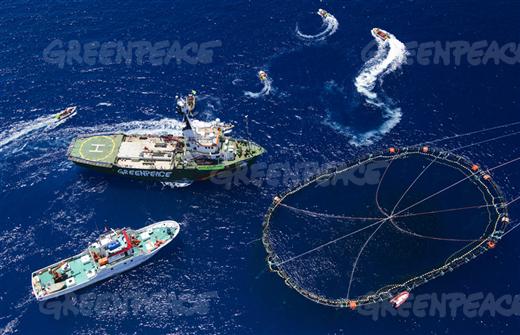
The popularization of the Japanese traditional sushi food in the 1970s has made the Bluefin Tuna one of the most endangered fish species in the world. It is estimated that current population is just 36 % of what it was in the 1970s, when industrial fishing already severely depleted the population.
Atlantic Bluefin Tuna feed on smaller fish such as mackerel, herring, squid, etc. The decline of these populations puts even more pressure on the Atlantic Bluefin Tuna populations. To make matters worse, Atlantic Bluefin Tuna only reach reproductive age around the age of 8. Paradoxically, until the late 1950s they had no commercial value at all: a giant Bluefin Tuna sold for only $0.11 per kg. Today, a 342kg Bluefin Tuna trades for a record $1,157 per kg and the Atlantic Bluefin Tuna business is worth about $1 billion annually!
Atlantic Bluefin Tuna are highly migratory fish and this makes it hard to enforce regulation. Most of the fishing occurs in the Mediterranean Sea: 7 European countries account for nearly 54% of the 2009 total allowed catch (TAC). These countries are Spain, France, Italy, Portugal, Malta, Greece and Cyprus.
A popular method is so-called farming: entire Atlantic Bluefin Tuna schools are located using GPS, sonar devices and airplanes and captured in giant floating cages (see photo). These floating cages are capable of holding up to 150 tonnes of fish. They are towed to the farms where the fish are fattened until they reach the desired size and weight. The biggest importer is Japan which accounts for 90% of demand. This intense activity usually produces a large amount of organic waste in the form of excess of food, fluids and antibiotics. These sediments accumulate on the seabed beneath the farm and can cause dead zones and seriously alter the surrounding ecosystem. Furthermore, these farms also attract birds, dolphins and other predators which can get stuck in the nets.
CCS – Carbon Capture and Storage
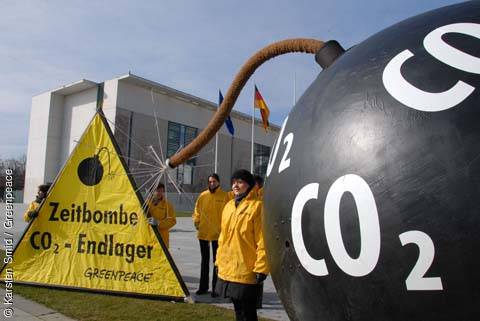 Right now the European Community plans large scale CCS (from fossil fired plants and heavy industry): about 240 new coal power plants with capturing technology for CO2 from waste gas, 22 000- 37 000 km of special CO2-Pipelines and 1,2 billion tons carbon dioxide annually squeezed in deep geological sites. Declared as an option against climate change, it shall serve for inacceptable prolonging of coal firing. But due to the increase of demand on energy (30-50% more), there will be more coal mining with additional release of climate changing methane and the “storage” isn´t save either – it means a great hazard for contamination of groundwater supplies with heavy metals and salty waters from deeper horizons. Planed “storage sites” are generously spread all over Europe and under the sea. In case of large scale implementation of CCS by the EC, not only the energy transition will be delayed irresponsibly with severe aftereffects on climate, also groundwater supplies for coming generations will be affected.
Right now the European Community plans large scale CCS (from fossil fired plants and heavy industry): about 240 new coal power plants with capturing technology for CO2 from waste gas, 22 000- 37 000 km of special CO2-Pipelines and 1,2 billion tons carbon dioxide annually squeezed in deep geological sites. Declared as an option against climate change, it shall serve for inacceptable prolonging of coal firing. But due to the increase of demand on energy (30-50% more), there will be more coal mining with additional release of climate changing methane and the “storage” isn´t save either – it means a great hazard for contamination of groundwater supplies with heavy metals and salty waters from deeper horizons. Planed “storage sites” are generously spread all over Europe and under the sea. In case of large scale implementation of CCS by the EC, not only the energy transition will be delayed irresponsibly with severe aftereffects on climate, also groundwater supplies for coming generations will be affected.
EU-Kommission Joint Research Center: EU-Pipeline Network and Costs: http://www.kein-co2-endlager-altmark.de/downloads/ldna24565enn.pdf
Prof. Dr. Olav Hohmeyer, Member of the German Advisory Council on the Environment http://www.kein-co2-endlager-altmark.de/downloads/microsoft-powerpoint—sinn-und-unsinn-von-ccs.pdf
The Ajka alumina sludge spill, 2010, Hungary

On the 4th of October 2010, the north-western corner of the dam of the Ajka Alumina plant collapsed. Between 700 000 cubic meters and 1 million cubic meters of highly caustic red mud are released and spread on 40km2 around the alumina plant. The red mud is composed by chromium, arsenic, sodium hydroxide and mercury, among other things.
During the mudslide, at least 8 people died and an hundred were injured in the process (mainly burns). The red mud infected agriculture lands and rivers on the surrounding area. Among the rivers touched were the river Raab, an affluent of the Danube (2nd longest river of Central Europe) and therefore causing a possible alteration of its ecosystem [2][3]. There are also potential health effects of red mud dust due to the emission of respirable alkaline particles into the air (in case of unfavorable meteorological conditions).
The Alumina plant belongs to The Magyar Aluminium Zrt Group, an Hungarian company created in 1995. The company have been sued, found guilty of toxic leaks and condemned to pay 472 millions of euros. Unable to pay the fine, the company files for bankruptcy. The European legislation does not recognize red mud as toxic waste, unless it is proved its contain high concentration of irritating substance, such as sodium hydroxide, which was the case in the Ajka plant.
Finally, the red mud issue is not isolated to Hungary, 70 billions of red mud are produced in the world each year in countries such as France, India and Vietnam.
-
http://www.theguardian.com/world/2010/oct/05/hungary-sludge-disaster-state-of-emergency
-
http://www.larecherche.fr/savoirs/environnement/quel-avenir-apres-boues-rouges-01-12-2011-88803
-
http://www.courrierinternational.com/article/2011/10/13/en-hongrie-un-an-apres-l-apocalypse-rouge
-
http://www.robindesbois.org/communiques/dechet/om/2011/boues-rouges-mal-mondial.html
Doñana
Doñana National Park is in Andalusia and has 104970 ha. In 1998 a raft of polluting waste from the Boliden company broke releasing five million cubic meters of toxic liquid and acid. After several years and much money the area was relatively “clean” but the company refused to pay the fine. The following year, hundreds of tons of fuel ended up on the beaches and coast of Doñana due to a crack in a pipe at a refinery. In addition the company has authorized Gas Natural to store gas in the basement of this park. This gas could seep into the aquifers with consequent damage to fauna, flora and population of the area.
http://www.wwf.es/que_hacemos/donana/salva_donana/
Great Barrier Reef under threat
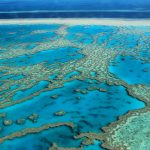
The Great Barrier Reef has been registered as a UNESCO World Heritage Site since 1981. It is the biggest reef of the world and has sheltered 400 different species of reef, 1,500 species of fish and 4,000 species of mollusk.
The region where the Great Barrier Reef belongs, Queensland, is one of the most dynamic regions of Australia in the field of the coal and gas industries. The problem is that this is causing damage on the Great Barrier Reef. Coal burning is the biggest fossil fuel contributor to climate change, the development of coal and gas industries led to the development of ports and infrastructure that in turn contribute to the degradation of the Great Barrier Reef’s ecosystem. Because the bulk of these fossil fuels are destined for export, it is also increasing marine traffic around the reef.
The construction of coal and gas infrastructure has put in jeopardy beaches, nesting grounds for turtles and seabirds, and mangroves, naturals habitats for marine life, birds and land based animals. According to a report from the Australian Government, mining activities could also be partly responsible for the degradation of water quality. Lastly, the development of coal export already have dredged 52,581,000m3 of the Great Barrier Reef between 2007 and 2011, and the Australian Government does not seem to be willing to stop the dredging, as it has just agreed to expand the Abbot Point site without informing the United Nations. The World Heritage Committee says “reef will be listed as threatened ecosystem unless government takes steps to protect it.”. European banks involved in coal or gas projects in the Great Barrier Reef include BNP Paribas, Crédit Agricole, Natixis, Royal Bank of Scotland, Société générale, Commerzbank, HSBC and ING group [8][9]
Mountaintop removal mining
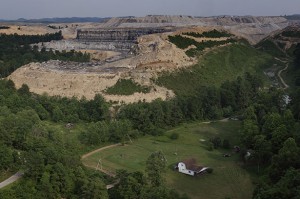 Mountaintop removal mining (MTR) is a form of surface mining that involves the mining of the summit or summit ridge of a mountain. Entire coal seams are removed from the top of a mountain, hill or ridge by removing the land above them. The resulting debris is then piled back on the ridge to reflect the approximate original contour of the mountain. The excess amounts of land (soil, stones, flora, and fauna) that cannot be replaced on the ridge-top are moved into neighbouring valleys and streams. It is the predominant method of coal mining in the Appalachian Mountains in the eastern United States. The process involves blasting the mountain with explosives to remove up to120 m of mountain to expose underlying coal seams. Excess rock and soil laden with toxic mining byproducts are often dumped into nearby valleys. The Luxembourgish Company Arcelor Mittal is involved in West Virginia.
Mountaintop removal mining (MTR) is a form of surface mining that involves the mining of the summit or summit ridge of a mountain. Entire coal seams are removed from the top of a mountain, hill or ridge by removing the land above them. The resulting debris is then piled back on the ridge to reflect the approximate original contour of the mountain. The excess amounts of land (soil, stones, flora, and fauna) that cannot be replaced on the ridge-top are moved into neighbouring valleys and streams. It is the predominant method of coal mining in the Appalachian Mountains in the eastern United States. The process involves blasting the mountain with explosives to remove up to120 m of mountain to expose underlying coal seams. Excess rock and soil laden with toxic mining byproducts are often dumped into nearby valleys. The Luxembourgish Company Arcelor Mittal is involved in West Virginia.
Opencast mines
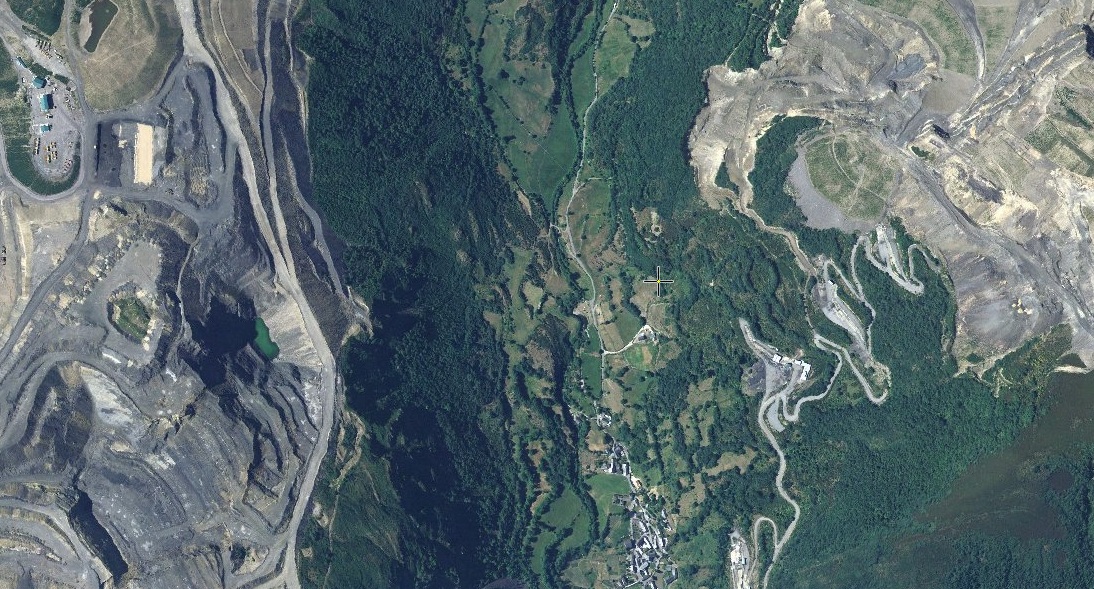 Laciana Leon region is nestled in the Sierra de los Ancares. This is an area of great biodiversity that has numerous forms of protection. However, it has proven the existence of numerous mines open with its attendant environmental impacts as heaven: destruction of vegetation cover, loss of ecosystems, modification of river channels and displacement of wildlife such as water pollution.
Laciana Leon region is nestled in the Sierra de los Ancares. This is an area of great biodiversity that has numerous forms of protection. However, it has proven the existence of numerous mines open with its attendant environmental impacts as heaven: destruction of vegetation cover, loss of ecosystems, modification of river channels and displacement of wildlife such as water pollution.
http://www.pensandoelterritorio.com/minas-a-cielo-abierto-el-desastre-disfrazado-de-oportunidad/
Ecocide in India – Bhopal 1984
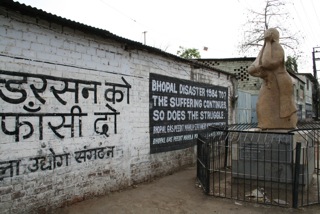
©Luca Frediani
The Bhopal disaster refers to a gas leak incident that occurred in India in 1984, in the region of Madhya Pradesh, 600km southern New Delhi. It resulted directly from the over exploitation of the UCIL plants (built in 1969 and 1978), a subsidiary of Union Carbide Corporation, among the biggest American chemical companies. The factory produced Temik and Sevin, two products of MIC considered extremely toxic, and that should be maintain under 0°C for safety reason (above 0°C, the liquid turning into a heavy gas). After a couple a years of underproduction due to bad economic conditions, the plants are run by a reduced team, in unsafe conditions. During this night of 1984, a succession of incidents led to the excessive pressure of a tank containing MIC, not spotted on time by operators, used to malfunctions of measure instruments and safety systems. A runaway reaction started, resulting in a very high temperature inside the tank 610. The overpressure broke the concrete roof, allowing about 40 metric tons of toxic gas to escape, leading to the so-called Bhopal disaster. Right after the disaster, UCC tried to charge the Indian subsidiary UCIL for the responsibility of the accident. After several years of struggle with public authorities and the civil society, UCC came to an agreement with the Indian government in 1989, implying 470 M USD (from 370USD to 533 USD per victim). In 1994, UCC sold UCIL, which after few transactions was taken over by the Madhya Pradesh regional government. In total denial, local authorities have been announcing that the site was not contaminated anymore, and in 2009, they even suggested to open the area for tourism. Almost 30 years after the disaster, the site remains non-decontaminated. The toxic wastes, from 4000 to 12000 tons, still stored on the site are polluting ground water and therefore, potentially poisoning people and ecosystems. In 2012, a project of decontamination run by the GIZ aborted because of ecologist association’s pressures (from Greenpeace notably) the project implying to move 347 tons of wastes to Europe, a highly risky convoy. This dramatic situation could stay for ages, as there is no decontamination center in India able to treat properly these wastes. Dow Chemical, a leader American company that brought out UCC in 2001 would be legally now the last resort moral person to pursuit. A petition supported by Greenpeace has been launched recently in order to force Dow Chemical to assume its responsibility, and raise awareness on the still critical situation of the ecosystem in Bhopal (http://bhopal.net).
1 Comment
delajudieantoine · Friday May 27th, 2016 at 04:36 PM
De bonnes infos, un des plus gros problème est la production d’énergies d’origine fossile. Que font les fournisseurs d’électricité ? Le renouvelable est prêt, il ne manque que quelques investissements. Les fournisseurs d’électricité à Toulon ont passé le cap eux.